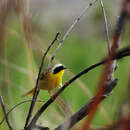Brief Summary
provided by EOL authors
The Common Yellowthroat (Geothlypis trichas) is a common breeding bird across most of North America, from Canada south through Mexico, with a winter range extending from the southern United States to northern South America.. Common Yellowthroats tend to stay low in grassy fields, thickets, and marshes. They breed most abundantly in marshes (especially cattails) and other very wet habitats with low, dense growth. During migration and in winter they are less closely associated with marshes and may occur in any sort of brushy or wooded area. The diet of the Common Yellowthroat consists mainly of insects and spiders, but includes some seeds. During courtship, the male displays to the female by flicking his wings and tail, following her closely, and performing a flight display in which he may climb up to 30 m in the air and returns to another low perch, calling and singing. Common Yellowthroats generally nest less than a meter from the ground. The nest is a bulky open cup built by the female and sometimes has a partial roof of material loosely attached to the rim. There are typically 3 to 5 (sometimes 6) eggs, which are creamy white with brown and black spots. The eggs are incubated (by the female only) for 12 days. The male feeds the female on the nest during incubation. Young are fed by both parents and leave the nest after 8 to 10 days. There are typically two broods per year. The young remain dependent on their parents for longer than most other wood warblers. Common Yellowthroats are very commonly "parasitized" by Brown-headed Cowbirds, which are "brood parasites", laying their eggs in the nests of birds of other species in lieu of building their own. Migration occurs mainly at night and in many areas is spread over a long period in both spring and fall. Despite habitat loss that has surely led to local declines, the Common Yellowthroat remains a common and widespread species in the United States and Canada. (Kaufman 1996; AOU 1998; Dunn and Alderfer 2011)

